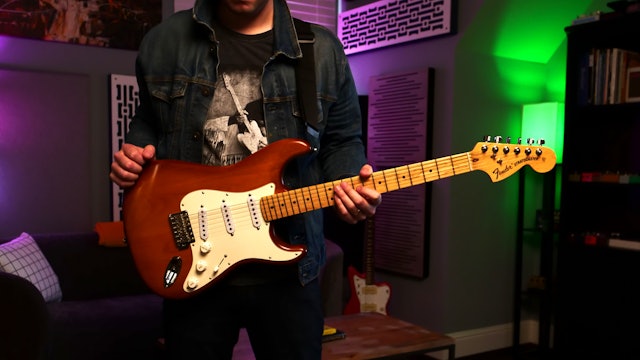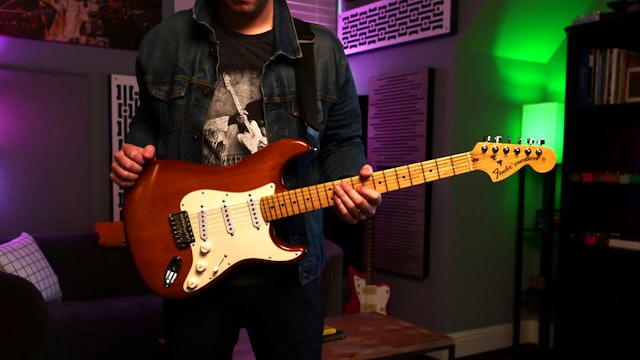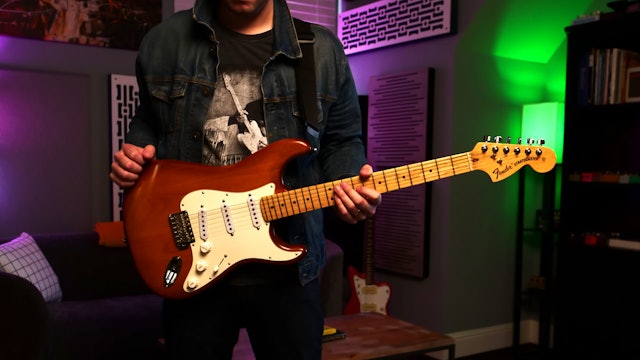Music Theory: Level 2
You can find all downloadable resources at the end of each curriculum in Guitar Super System, or altogether for use outside the app at https://musiciswin.com/resources
Those familiar with basic to intermediate music theory may opt to start here, although I recommend skimming through Music Theory: Level 1 to fill in any gaps. You’ll learn to play the seven modes of the Melodic Minor Scale and the theory behind it, including diatonic chords, triads and all four string sets, arpeggios in multiple octaves, and as always, how to use these concepts in your own guitar playing.
-
Introduction to the Melodic Minor Scale
The Melodic Minor Scale is your first step into the world of becoming a more advanced guitarist from a music theory perspective, because it challenges your ear to absorb sound in a way that is probably not familiar to you. With just one note differentiating the Melodic Minor Scale from the Major ...
-
Melodic Minor Scale Playing Examples
Most of what makes the Melodic Minor Scale unique is one simple note, but understanding how to implement that knowledge to create a coherent melody or solo in the Melodic Minor tonality is an entire new ballgame. Get these mode positions under your fingers and experience the strange, beautiful so...
-
The Definitive Guide to Intervals
Intervals in music are an essential foundation for understanding how to use various modal scales to your advantage. Knowing certain intervals can make certain sounds when played over certain chords will allow you to see the fretboard in a whole new way. With this knowledge, you can discover new w...
-
Melodic Minor "Home Riffs" Demonstration
A "Home Riff" is a term I use to describe a riff you can use in any key, as long as you know what Mode you're playing in. In this example, I establish a Home Riff over the G Ionian b3 Mode, which I as a home base to return to between other melodic ideas.
-
Testing Your Triad Knowledge
Being able to recall and identify Triads on any string set and from any inversion is an important exercise to do if you want to implement Triads in your improvisation. This lesson contains only closed voice triads, as opposed to closed and open triads, but this type of exercise is something I sti...
-
How to Memorize Triads
Each string set contains different triadic shapes, and by learning these shapes you will unlock the fretboard in a way most guitarists never will.
-
Triad Practice Video Backing Track
For downloadable PDFs and backing tracks, use the Resources Tab in the navigation bar of Guitar Super System.
Use the graphics to anticipate which Triad will be coming next so you can get in position to play different inversions over these chords. You can start with just playing root position Tr...
-
Demonstration - Using Triads to Improvise
Triads are essential to being a well-rounded guitar player. If you have any desire to learn how to create your own guitar solos, relying on scales is not going to cut it. In fact, when people ask the question "How do I sound like I'm not just playing scales when I solo?" the answer is always the ...
-
Master Chord List: Part 1
For downloadable PDFs and backing tracks, use the Resources Tab in the navigation bar of Guitar Super System.
Having a sizable arsenal of simple (to complex) chords is something many guitar players undervalue. I’ve been inspired to write an entire song just by hearing one really cool-sounding ch...
-
Complete Chord Library - Volume 2
Part 2 of the Complete Chord Library.
-
Complete Chord Library - Volume 3
Part 3 of the Complete Chord Library.
-
Complete Chord Library - Volume 4
Part 4 of the Complete Chord Library.
-
7 Modern Chord Progressions
Sometimes, we need an alternate source of inspiration when we're in a creative rut. I've plucked these seven amazing chord progressions from piano etudes, orchestral movements, and more to show you a new spectrum of sound you may be missing, in hopes to pull you out of the jail that can be writer...
-
The Most Epic Chord Change Possible
What is the most epic chord change you know? I offer my own opinion in today's lesson, where the chord change is also one of the most simple. If you have no idea what I'm talking about, you should learn about intervals. While there is no correct answer to what the most epic chord change is, these...
-
The 5 Most Useful Power Chords
Some guitar players earlier in their journey may know one or two power chords, but there are actually many useful variations of these shapes which I'll show you in this lesson.
-
Beautiful, Moveable Open-String Chords
You've heard of clickbait, right? Well, this title is the opposite of clickbait. In this lesson, I'll show you open-string chords that are moveable, and sound beautiful. Sometimes all it takes is one chord or even one note to inspire you, so hopefully that happens today.
-
Using Arpeggios to Improvise (demonstration)
Arpeggios are not just a flashy trick for shred lords. They are an extremely useful tool for any guitar player, no matter what genre of music you prefer. In this lesson, I demonstrate how using arpeggios can help you navigate through difficult chord changes by outlining essential chord tones to f...
-
ARP Arpeggio Practice Video Backing Track
A chord progression derived from Melodic MInor, use Arpeggio shapes over this track to practice your own improvised soloing. You can use Triad Arpeggios depending on the tonality (major, minor, augmented, diminished) of the chord, and it is best to start with playing the shapes verbatim to begin ...
-
Using Diminished Arpeggios Over Blues Chords
If you've ever wanted to turn heads during your blues solos, the diminished sound is a great way to accomplish that. Just to avoid any confusion for those who care, the Diminished "scale" as I refer to it in this particular video is technically a seventh arpeggio, but I find these intervals are t...
-
Melodic-Minor-Scale-3-Octaves.pdf
87.2 KB
-
Arpeggio-Practice-Backing-Track.mp3
4.96 MB
-
G-Melodic-Minor-Backing-Track.mp3
4.93 MB

























